To use vintage lenses on your modern camera, you'll need an adapter that matches your lens mount type to your camera's mount system. First, identify your lens mount (like M42, Canon FD, or Nikon F) and your camera's mount (like Sony E, Canon RF, or Fuji X). The adapter must account for the correct flange distance between lens and sensor. Quality metal adapters work best, and popular combinations include M42 to Sony E-mount or Canon FD to mirrorless. Let's explore your specific setup to guarantee perfect compatibility.
Understanding Basic Lens Mount Types

The world of lens mounts can initially seem overwhelming, but understanding the basic types will help you navigate adapter options for vintage lenses.
Getting familiar with lens mount types is the key to unlocking the full potential of vintage glass.
You'll encounter several common mounts in your vintage lens journey. The C-Mount, with its 1" diameter thread and 17.526mm flange distance, is prevalent in machine vision applications. Its cousin, the CS-Mount, shares similar specs but has a shorter 12.526mm flange distance. C-Mount lenses are incompatible with CS-Mount cameras due to their longer flange distance.
For SLR cameras, you'll find the Nikon F-Mount, featuring a bayonet-style connection and 46.5mm flange distance. The S-Mount (M12) is popular in surveillance equipment, while the TFL and TFL-II mounts cater to larger sensors.
Each mount type has distinct characteristics that'll determine which adapter you'll need for your camera system.
Determining Your Camera's Mount System
Before diving into vintage lens adapters, you'll need to identify your camera's mount system – an essential first step that determines compatibility options.
Major camera brands use specific mounts: Canon relies on EF mount for DSLRs and RF for mirrorless, while Nikon uses F mount for SLRs and Z mount for mirrorless cameras. Sony cameras feature the E-mount system, Fujifilm uses X mount, and Pentax employs K mount.
Some lens mounts, like Nikon's F-mount, feature a 44mm diameter bayonet design that has remained largely unchanged for decades.
Look at your camera's documentation or check the mount marking near the lens attachment point.
If you're using a mirrorless camera, you'll have more flexibility with vintage lens adaptation due to the shorter flange distance. DSLR bodies might require specialized adapters for proper functionality.
Understanding your camera's mount type will help you select the correct adapter for your vintage lenses.
Measuring Flange Distance and Compatibility
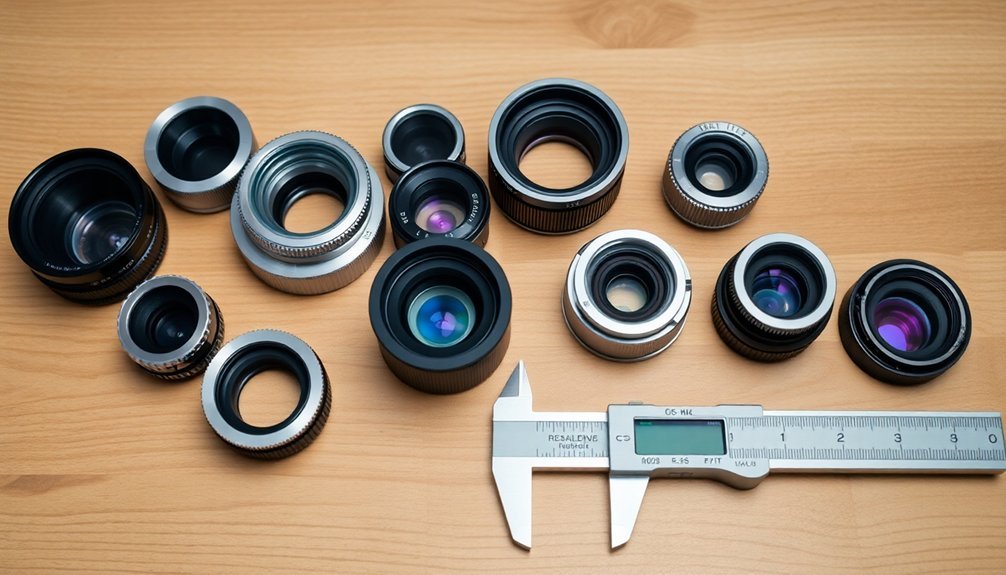
You'll need a digital caliper to measure flange distances accurately, as even tiny variations of 0.01mm can affect your lens's ability to focus at infinity.
When calculating adapter stack height, subtract your camera's flange distance from the lens mount's distance to determine the exact thickness needed for proper focusing. For unknown vintage lenses, you can find the flange distance by measuring from the rear element to film plane when focused at infinity.
Using your digital caliper correctly means ensuring it's properly calibrated, keeping the measuring surfaces clean, and taking multiple measurements to confirm consistency.
Mount Distance Measuring Tools
When adapting vintage lenses to modern cameras, precise measurement of flange distance becomes essential for achieving proper focus and functionality. You'll need specialized tools to guarantee accurate measurements.
A high-quality vernier caliper, like those made by Mitutoyo, offers the precision you'll need for basic measurements. The ideal gap should match the flange focal distance of your specific camera mount system. For more specialized work, you'll want to take into account depth gauges designed specifically for camera mounts.
Ground glass viewfinders help you align the image plane with the lens focus plane when taking manual measurements.
In professional settings, you might encounter collimator telescopes or vintage Leitz depth measuring devices. These tools provide extremely accurate readings of flange-to-film plane distances.
Whatever tool you choose, remember that even small measurement errors can greatly impact your lens's focusing ability.
Calculating Adapter Stack Height
Adapting vintage lenses successfully requires precise calculation of the adapter stack height – a critical measurement that determines whether your lens will achieve proper focus.
To calculate the necessary adapter height, you'll need to subtract your camera's flange distance from your lens's native mount flange distance.
- If your camera's flange distance is shorter than the lens's native mount (common with mirrorless cameras), you can use a simple mechanical adapter.
- When the camera's flange distance is longer, you'll need an adapter with optical elements to maintain infinity focus.
- For accurate calculations, look up your specific mount distances using online resources or manufacturer specifications.
- Remember that sensor size affects compatibility – confirm your vintage lens provides adequate coverage for your camera's sensor.
This calculation confirms proper focusing and helps you choose the right adapter type for your specific setup. Companies like Fotodiox make adapters for many common lens and camera combinations, simplifying the process of finding the right solution.
Digital Caliper Best Practices
Three essential steps guarantee accurate flange distance measurements with digital calipers. First, you'll need to zero your calipers before each measurement to maintain precision.
Next, position the calipers perfectly perpendicular to the mounting surface to avoid angular errors that could skew your readings. The included hard-shell case helps protect the calipers from damage that could affect measurement accuracy.
When measuring, you'll want to switch between millimeters and inches as needed, since vintage lens specifications often use different units. Handle the inside jaws with care to prevent damage that could affect accuracy.
For challenging measurements, like internal depths, you might need to use gauge pins alongside your calipers. Remember that digital calipers offer accuracy to 0.001 inches (0.02mm), which is vital when determining adapter compatibility for your vintage lenses.
Popular Vintage Lens Combinations
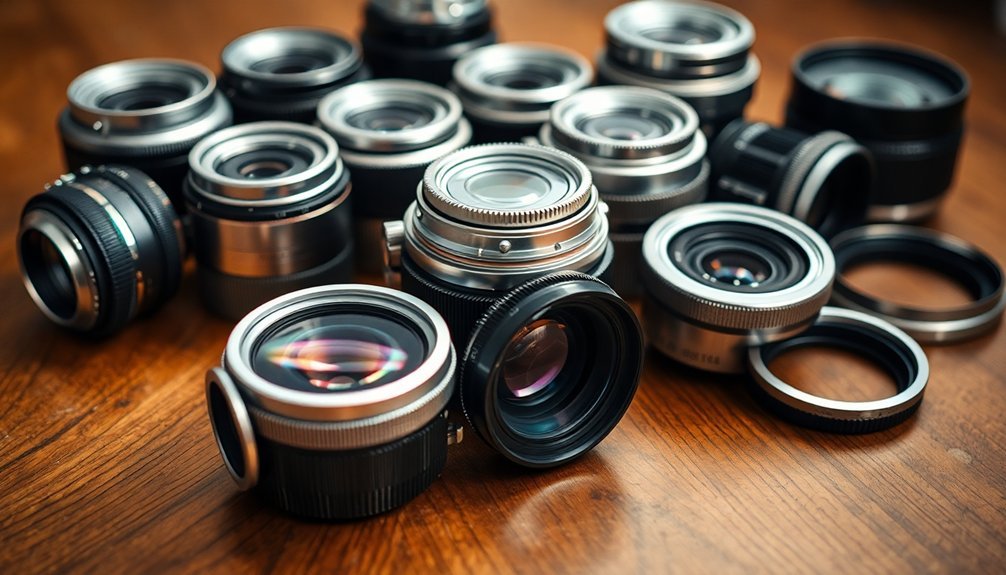
You'll find that mounting M42 lenses on Sony E-mount cameras leads to superb results, especially with classics like the Helios 44M 58mm and its famous swirly bokeh effect.
Canon FD film lenses shine on mirrorless bodies, with the FD 50mm f/1.4 SSC delivering cinematic flares and beautiful color rendition.
These combinations offer excellent value while maintaining high optical quality, making them popular choices among vintage lens enthusiasts. The Minolta 50mm f/1.4 delivers exceptional resolution and beautiful bokeh when adapted to modern cameras.
M42 to Sony E-Mount
The combination of M42 vintage lenses with Sony E-mount cameras has become increasingly popular among photographers seeking unique visual characteristics at affordable prices.
Using an all-metal adapter, you'll be able to mount classic lenses like Helios, TAKUMAR, and Carl Zeiss Jena onto your Sony Alpha camera body. The adapter's matting varnish interior helps prevent unwanted light reflections during shooting.
These affordable adapters offer you:
- Manual focus capability with your camera's focus peaking feature
- Full infinity focus support for landscape and astrophotography
- Access to unique vintage lens characteristics like special bokeh effects
- Cost-effective expansion of your lens collection
While you'll need to operate these lenses manually and won't have autofocus, the creative possibilities are extensive.
You can find quality adapters from manufacturers like K&F Concept and Urth for under $45 through major retailers.
Canon FD Film Classics
Classic Canon FD lenses have earned their reputation among vintage glass enthusiasts since their 1971 debut.
When choosing an FD lens for your modern camera, you'll need an appropriate adapter that matches your camera's mount system.
If you're using a mirrorless camera, you'll find adapting FD lenses relatively straightforward due to the shorter flange distance.
For Canon EF bodies, you'll need a mechanical adapter, though you'll lose infinity focus capability. These adapters provide a basic physical connection between the lens and camera body.
Popular FD choices include the 28mm f/2 for wide-angle shots, the versatile 50mm f/1.4 for everyday photography, and the 85mm f/1.8 for portraits.
For zoom lovers, consider the FD 28-50mm f/3.5 or the FD 70-210mm f/4.0.
While you'll need to focus manually, these lenses deliver unique character and bokeh that many modern lenses can't match.
Selecting Quality Adapters for Your Setup
When choosing adapters for vintage lenses, understanding quality indicators can mean the difference between a frustrating experience and seamless compatibility.
You'll want to focus on metal construction over plastic to guarantee durability and minimize light leaks. Research the specific mount combinations you need, as not all vintage lenses can adapt to every modern camera system. Since mirrorless cameras require additional spacing between the lens and sensor, adapters are essential components for vintage lens setups.
- Check the flange distance requirements for your lens-to-camera combination
- Determine if you need an active adapter for electronic functions
- Verify compatibility through user reviews and product specifications
- Consider whether you need additional features like built-in filters or tripod mounts
Before making your purchase, confirm the seller's reputation and return policy.
While budget options exist, investing in a quality adapter will often save you money and frustration in the long run.
Manual Focus and Exposure Considerations
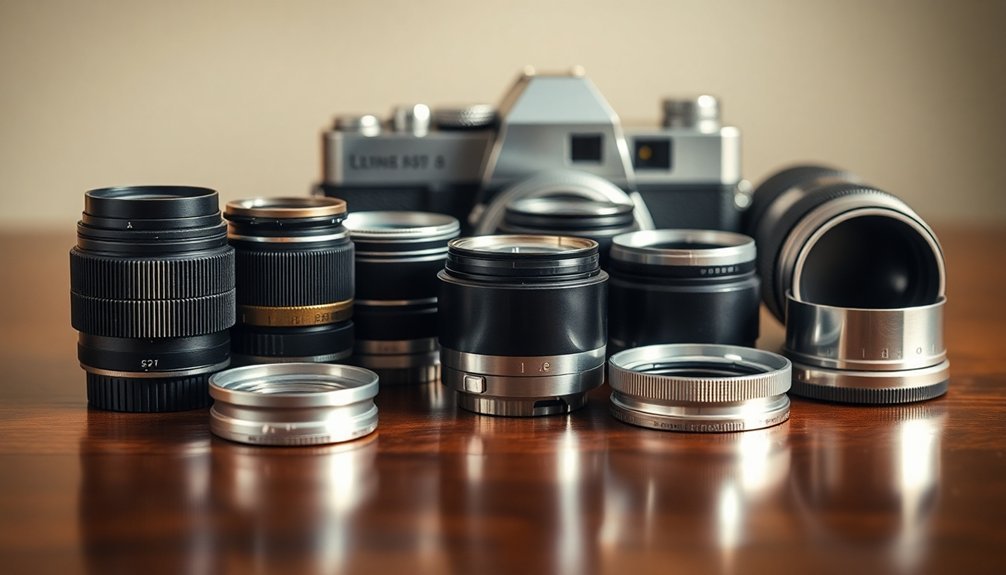
Mastering manual focus and exposure with vintage lenses requires understanding both your camera's modern features and traditional focusing techniques.
You'll need to rely on focus peaking and magnification tools while developing your manual focusing skills through consistent practice. Taking time to properly set your diopter will ensure accurate focusing through your viewfinder.
When shooting, you'll find aperture priority mode particularly useful, as it lets you control the aperture manually while your camera handles shutter speed.
Since vintage lenses don't communicate with modern camera meters, you'll need to use exposure compensation or manual metering to achieve proper exposure.
To overcome challenges in low light or with moving subjects, you can use zone focusing techniques and pre-set focus distances.
While there's a learning curve, you'll discover that vintage lenses offer unique image qualities and creative control that make mastering these manual skills worthwhile.
Common Mounting Issues and Solutions
Beyond mastering manual controls, the successful use of vintage lenses hinges on proper mounting techniques and adapter selection. You'll encounter several common issues, from flange distance errors to mounting wobble, but these challenges are solvable with the right approach.
To guarantee reliable mounting of your vintage lenses:
- Select high-quality CNC-machined adapters that match both your lens and camera mounts precisely.
- Check the adapter's build quality, avoiding cheap options that can cause focus shifts.
- Consider professional lens modification services if you're using a particular vintage lens frequently.
- Learn proper handling techniques to prevent misalignment and secure mounting.
When choosing adapters, prioritize those with positive user reviews and robust construction. While premium adapters cost more initially, they'll save you from frustration and potential damage to your equipment. For specialized solutions, the Sim Mod adaptation system offers professional-grade mounting stability for video production needs.
Maintenance and Care for Lens Adapters
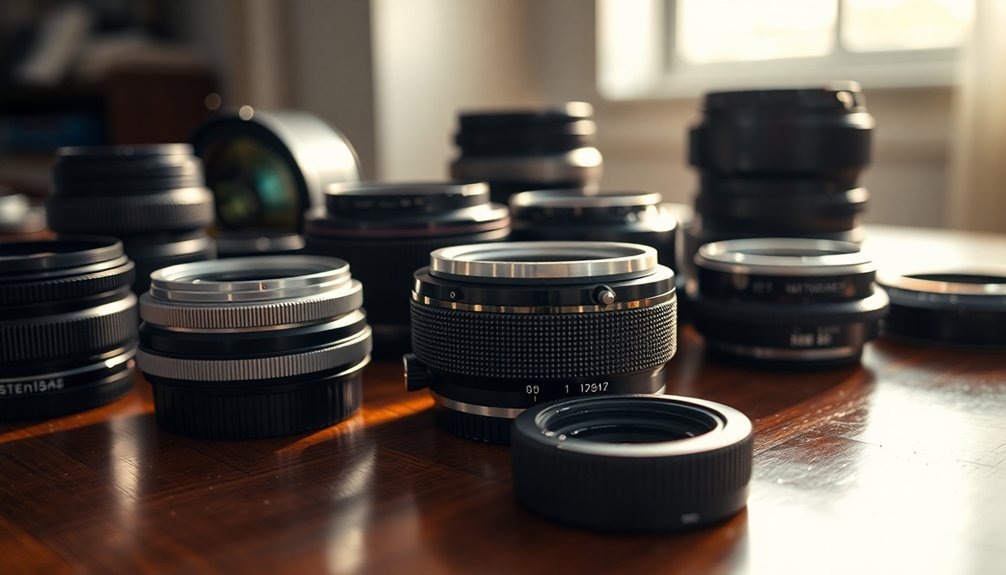
Proper maintenance of lens adapters directly impacts their longevity and performance.
Taking good care of your lens adapters ensures they'll serve you well and last longer, maximizing your photography investment.
You'll need to keep your adapters clean using gentle methods, avoiding any harsh materials that could damage their protective coatings. A blower is your best tool for removing dust, while compressed air (oil-free) can tackle stubborn debris. When issues persist, professional lens cleaning is available under clean-room conditions.
Store your adapters in a protective case when they're not in use, and keep them in a cool, dry environment away from harmful substances like naphtha or camphor.
Don't attempt to disassemble your adapter, as this will void the warranty. Regular inspections help you spot potential issues early, preventing long-term damage.
Remember to handle your adapters with care and avoid exposing them to extreme temperatures or direct sunlight. Document your maintenance routine for future reference.
Frequently Asked Questions
Can I Stack Multiple Lens Adapters for More Versatility?
While you can stack multiple adapters, it's not recommended. You'll likely experience reduced image quality, mechanical instability, and focusing issues. It's better to invest in a single, high-quality adapter for your needs.
Do Weather-Sealed Vintage Lens Adapters Exist?
Yes, you'll find weather-sealed vintage lens adapters available, though they're less common and more expensive. They're great for protecting your gear when shooting outdoors, offering enhanced durability against moisture and dust.
Will Using Adapters Affect My Camera's Warranty?
Using adapters typically won't void your warranty unless they cause mechanical damage. However, you should check your camera's specific warranty policy, as some manufacturers don't cover issues related to non-native accessories.
How Often Should I Replace My Lens Adapter?
You don't need to replace your lens adapter unless it's physically damaged or shows signs of wear. With proper care and maintenance, a well-made adapter can last indefinitely through regular use.
Can Electronic Aperture Control Be Added to Fully Manual Adapters?
You can't typically add electronic aperture control to fully manual adapters. You'll need to purchase a new adapter with built-in electronic components to enable aperture control with your camera body.
In Summary
You'll find that adapting vintage lenses is a rewarding way to expand your photography options while saving money. Remember to measure your flange distance, choose high-quality adapters, and accept that you'll need to work with manual settings. Keep your adapters clean and properly stored between uses. With the right adapter and a bit of practice, you'll breathe new life into classic glass.
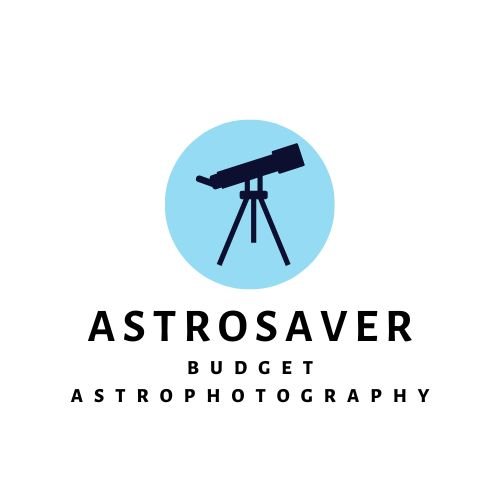

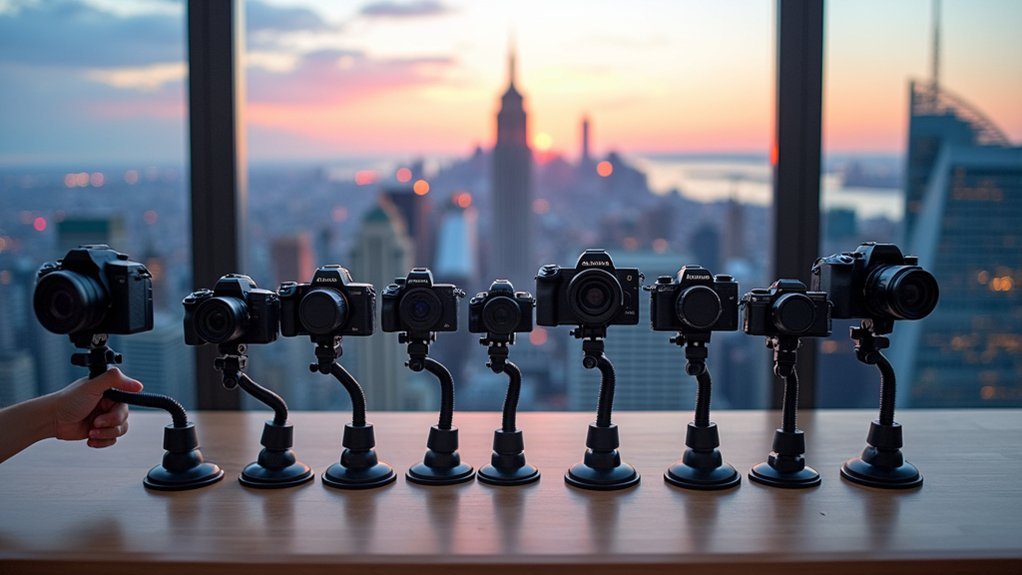
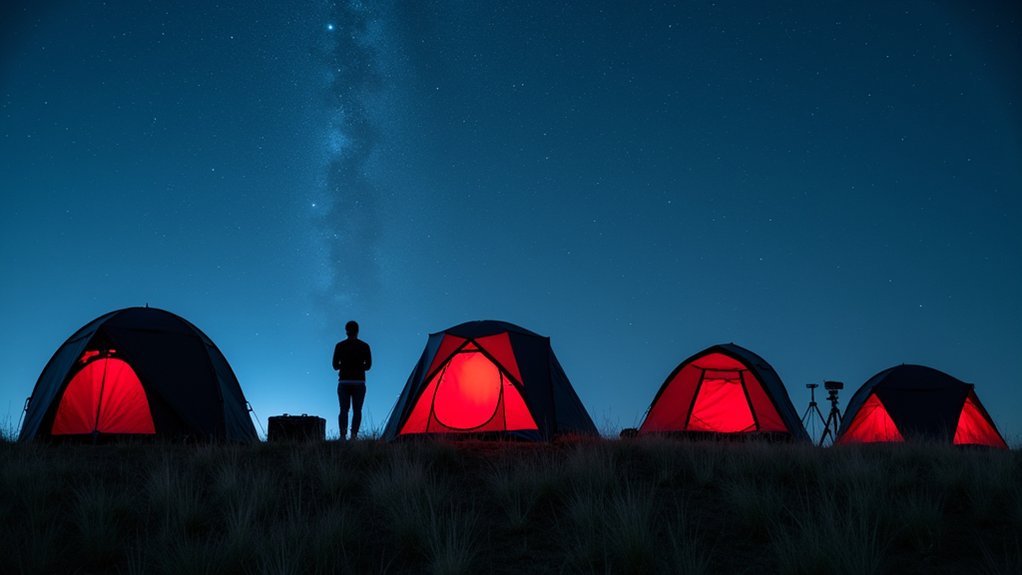
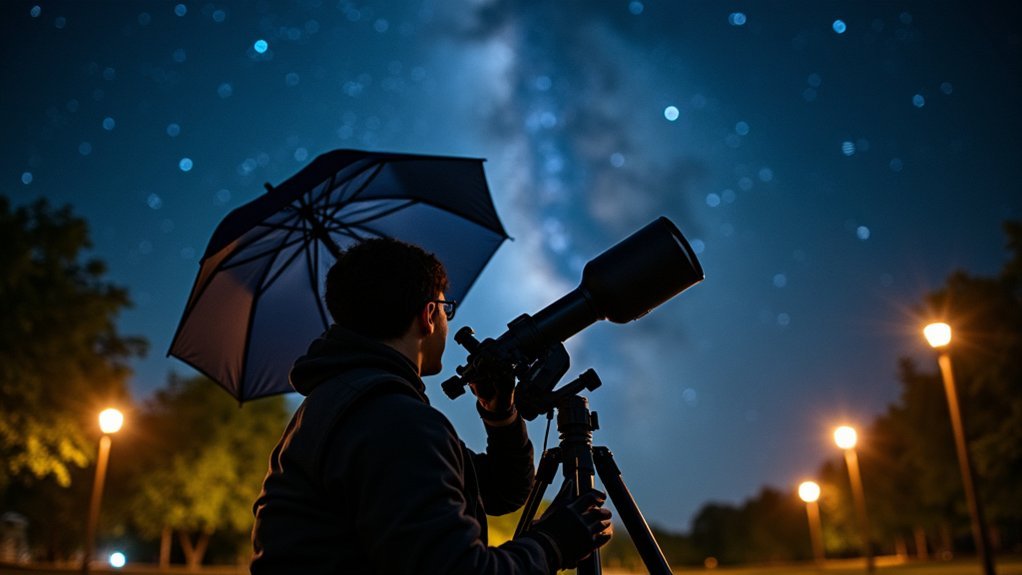
Leave a Reply